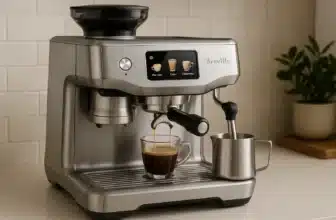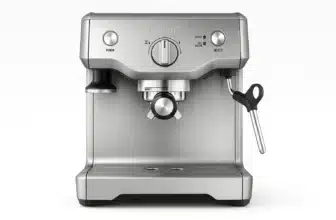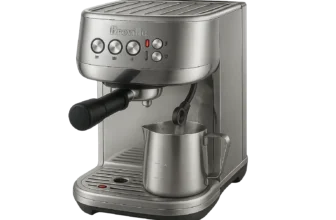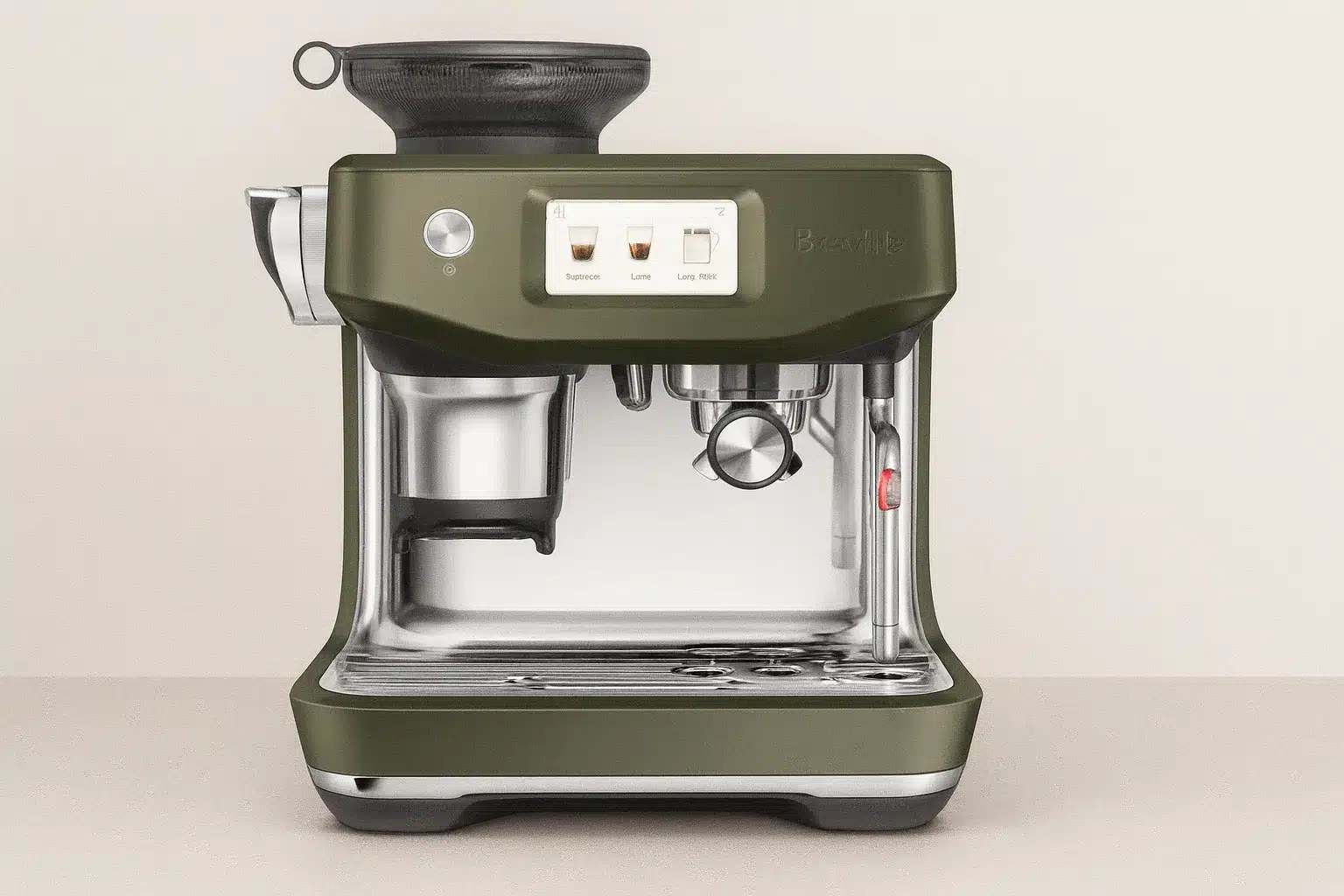
OneHundredCoffee is reader-supported, and some products displayed may earn us an affiliate commission. Details
I’ve brewed hundreds of shots on the Breville Barista Touch Impress (BES881BSS), and I’ve learned exactly where it shines, where it’s simply “good enough,” and where you can squeeze out café-level results with a little practice. If you’ve ever wanted barista-style control without the headache of dialing every tiny setting from scratch each morning, this machine feels like that sweet middle ground: it blends smart guidance with hands-on craft. The “Touch” gives you a friendly, bright touchscreen that walks you through drinks and steaming; the “Impress” adds Breville’s clever assisted dosing and tamping so your puck is consistent even when you’re still finding your rhythm.

Breville Barista Impress Espresso Machine (BES881BSS)
Key Features
- Integrated conical burr grinder for fresh, on-demand dosing
- Impress Puck System: assisted dosing & tamping for consistency
- Low-pressure pre-infusion and ~9-bar extraction
- Manual steam wand for latte-art microfoam
- 54 mm portafilter; programmable single/double shots
Why We Like It
A streamlined all-in-one that shortens the learning curve: the assisted tamping keeps shots consistent while the steam wand delivers proper texture for lattes and cappuccinos.
Pros
- Assisted tamping reduces channeling
- Built-in grinder saves space and time
- Reliable microfoam for latte art
- Beginner-friendly controls with room to grow
Cons
- Less upgradeable than separate grinder + machine
- Requires regular cleaning/backflushing
Bottom Line
A smart step-up for newcomers: consistent puck prep, solid espresso, and café-worthy milk in a compact footprint.
Price on AmazonI’m a tinkerer by nature, but I also like my morning coffee fast. Over weeks of daily use, I leaned into the guided recipes when I was rushed, then dove deeper on the days I wanted to geek out. I intentionally tested it with a range of beans—bright, lemony single-origins, chocolate-heavy blends, and a couple of dark roasts—to see how the built-in grinder behaved. I steamed milk for cappuccinos and flat whites (hello, silky microfoam), pulled longer lungos for iced drinks, and even tested the cup clearance with my go-to ceramic mugs. What follows is a section-by-section breakdown of the real experience—what it’s like to live with the Barista Touch Impress on your counter, not just what the spec sheet says.
Our Best Reviewed Breville Coffee and Espresso Machines
| Image | Product | Features | Price |
|---|---|---|---|
Best Assisted Tamping  |
| Price on Amazon | |
 |
| Price on Amazon | |
Best Dual Boiler Value  |
| Price on Amazon | |
Best Touchscreen All-in-One  |
| Price on Amazon | |
Best Mid-Range All-In-One  |
| Price on Amazon | |
Best Hands-Off Café Experience  |
| Price on Amazon | |
Best All-in-One Espresso Machine for Serious Home Baristas  |
| Price on Amazon | |
Best All-in-One Starter 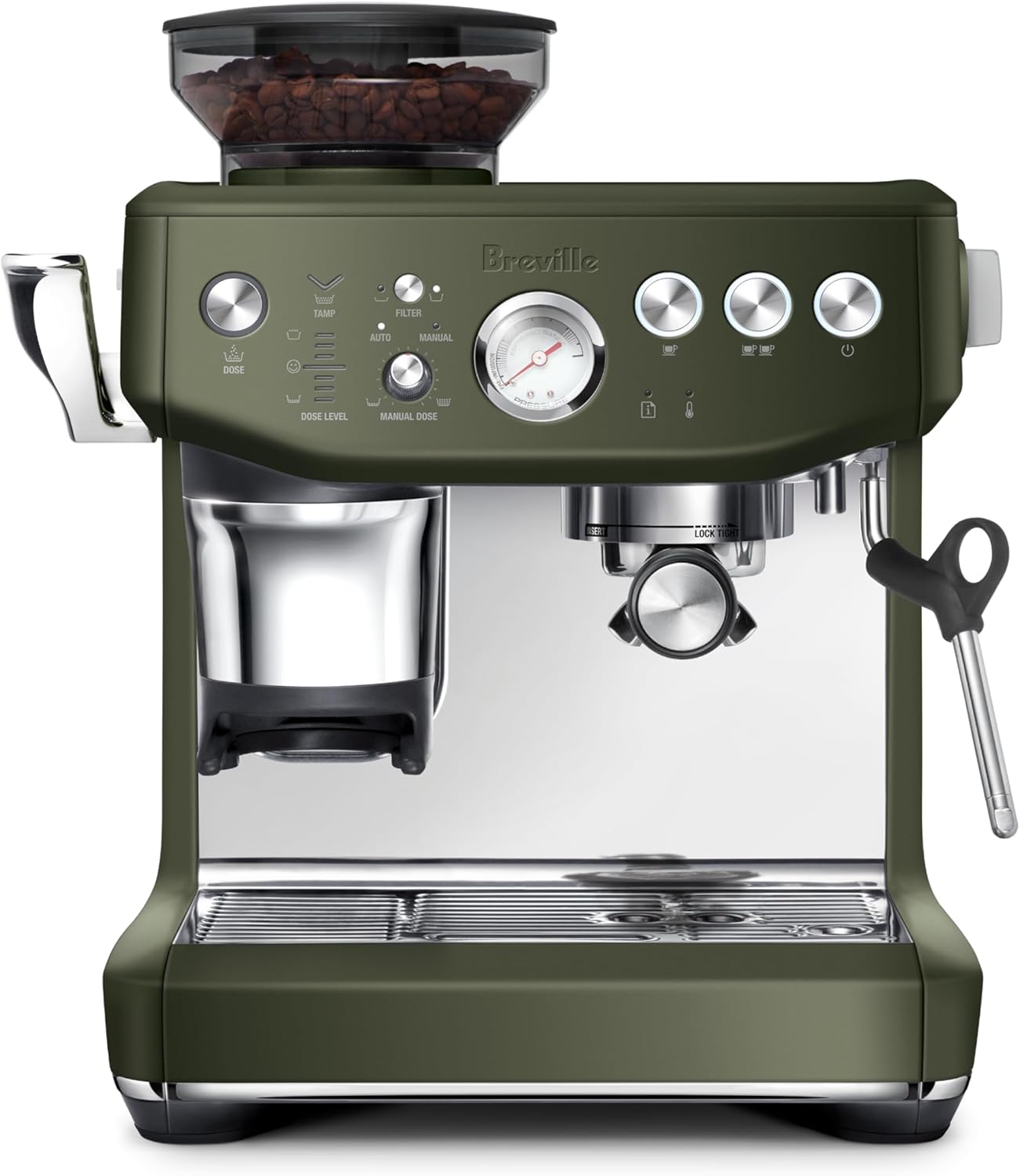 | Breville Barista Express Impress Espresso Machine (BES876BSS) |
| Price on Amazon |
Size & Design: Counter-Friendly, Purposeful, and Familiar
Out of the box, the Barista Touch Impress looks unapologetically Breville: brushed stainless steel, clear lines, and an industrial-leaning elegance that avoids looking “gadgety.” In my smallish kitchen, footprint matters. This is a serious machine, but it’s still counter-friendly; it doesn’t sprawl like a full prosumer setup with a separate grinder. The integrated design keeps everything tidy: grinder and hopper up top, portafilter and grouphead front-and-center, water tank at the rear with easy access.
The top surface is flat and slightly warm during operation—a convenient cup-warming deck that actually gets used. The drip tray fits snugly and pulls out smoothly for rinsing, with a “change me” indicator that pops up when it’s getting full (a small touch that prevents surprise overflows). Fit and finish are solid; panels don’t flex or rattle when you lock in the portafilter. After weeks of use, wiping it down remains easy—the stainless hides fingerprints better than mirror-polished machines, and the corners aren’t dust traps.
Bottom line: if you want a compact, all-in-one that still looks like a “real” espresso machine, the design here hits that tight line between serious and friendly.
Colors & Finish: The Stainless Steel Sweet Spot
The BES881BSS I tested is the classic brushed stainless finish. It’s neutral, matches other appliances, and still reads “premium.” While Breville sometimes offers alternate finishes for other models, the stainless variant is the sure bet for most kitchens. Over time, I noticed the brushed texture hides micro-scratches better than glossy finishes. Daily cleaning with a soft cloth keeps it looking brand new. If your kitchen lighting leans warm, the stainless takes on a cozy glow; in cooler lighting, it looks crisp and professional. Either way, it never clashes.
User Interface: The Touchscreen That Actually Helps
The “Touch” in Barista Touch Impress isn’t a gimmick. The touchscreen UI is bright, responsive, and designed for people who don’t want to memorize workflows. It offers guided drink icons (espresso, latte, cappuccino, flat white, and more) and walks you through the essential steps—grind → dose → tamp → brew → steam—with just the right amount of instruction for beginners, while staying out of the way for experienced users.
Creating and saving custom drinks is where it becomes your machine. I saved a “Double-Oat Flat White” profile with my preferred grind steps, shot volume/time, and milk temp/foam level. On busy mornings, I tap the custom tile and follow the prompts, and it delivers repeatable results without me hovering over every parameter. On weekends, I’ll switch to manual control and adjust variables on the fly. That dual nature—guided when you want it, handcrafted when you don’t—is the Barista Touch Impress at its best.
The UI language is clear and friendly. It shows progress bars and icons that make sense, and the menu layout is easy to navigate, even with foam-splattered fingers. Compared to knob-and-button machines, this feels more modern and less error-prone.
Water Tank: Capacity, Access, and Filtration
The rear water tank is transparent enough to check levels at a glance and simple to lift off for refilling at the sink. You can also top up with a pitcher without removing it. The machine accommodates water filters to reduce scale and off flavors—if your tap water is hard or chlorinated, using the filter plus periodic descaling makes a noticeable difference in taste and longevity.
I tested with both filtered tap and bottled spring water. With filtered tap water, crema was more consistent, and non-bitter edges smoothed out. The tank seals securely when replaced—no dribbles or awkward seating—and the machine detects when water is low before you get halfway through a shot, which saves frustration.
Built-In Coffee Grinder: Integrated, Capable, and Calibratable
An integrated grinder is one of the main reasons to choose this machine, and the Barista Touch Impress’s burr grinder is legitimately capable. You adjust grind size via a dial, and you can tweak grind time/quantity in the UI. The Impress system measures dose consistency shot-to-shot and will nudge the grind quantity automatically to hit your target puck height. In daily use, that means I get fewer “off” shots when I switch beans or as freshness changes during the week.
I pushed the grinder through light, medium, and dark roasts. For light roasts, I needed to go finer and adjust the dose slightly higher; for darker roasts, coarser settings and a lighter dose worked well. Retention is low for an integrated unit, and static was manageable (a couple of light taps on the portafilter cradle clears stray grounds). Grind distribution into the 54 mm basket is even, and the centered chute minimizes clumping compared to older designs.
Is it as granular as a top-tier standalone grinder? Not quite—but it’s more than good enough to deliver nuanced shots with real clarity. Most users will appreciate the convenience and the remarkable consistency the dosing logic provides.
Portafilter & Baskets: The Hands-On Interface
Breville sticks with its 54 mm portafilter format. It’s sturdy, well-balanced in hand, and locks in with a satisfying cam action that never feels crunchy or vague. The included baskets cover single, double, and (in some kits) pressurized options. I mostly used the non-pressurized double basket for flavor clarity and proper workflow practice. The spouts distribute well, and I had no issues placing shot glasses or a small scale beneath.
While some enthusiasts prefer 58 mm for accessory compatibility, the 54 mm ecosystem is now broad enough to get you a tamp, distributor, and puck screen if you want to accessorize. Out of the box, the included tools are perfectly sufficient; the real magic, though, is the Impress tamping (next section), which changes the portafilter game on this machine.
Automatic or Manual Dose: Assisted Precision With the Impress System
This is the hallmark feature. The Impress system combines assisted dosing and tamping to get your puck to a consistent height and density. After a grind, the machine evaluates the puck level and guides you to tamp with a calibrated lever—not an electric gimmick, but a mechanical assist that applies the right pressure and finishes with a neat 7° barista twist. The UI will tell you if you need a touch more grounds or if you’ve nailed it.
In practice, it slashes the learning curve. On day one, my pucks were uniform and my shot times fell into a tight band without me fussing. When I switched to a new bag of beans, the system rapidly re-centered my dose within a couple of pulls. You can still go fully manual—adjust grind, change dose time, tamp more or less—but the assisted path is consistent and fast. If you share the machine with family, the Impress feature keeps everyone’s shots in the same ballpark.
Pre-Infusion & Heating: Gentle Start, Fast Heat
Breville’s approach to pre-infusion—a gentle wetting of the puck before full pressure—helps reduce channeling and encourages even extraction, especially when your puck prep is “pretty good” but not perfect (which is most mornings for most people). In my testing, pre-infusion made light roasts less spiky and sour, and it improved crema uniformity.
The heating system comes to temperature very quickly from cold. From wake-up to espresso is short enough that I’m not pacing the kitchen. Temperature recovery between shots is also snappy, which matters when you’re pulling a couple of drinks back-to-back. While the machine isn’t a dual-boiler prosumer beast, for home use, it’s remarkably speedy and stable for its class.
Cup Size & Clearance: Real-World Usability
Cup clearance is a bigger deal than it sounds. With short glasses and most cappuccino cups, I slide them under the spouts without contortions. For taller mugs, I pull into shot glasses and then combine in the mug, or I remove the drip-tray grid to cheat a bit of extra space. If you’re an Americano-in-a-tall-mug person every morning, you’ll adapt to the quick transfer method in about two days—it’s a non-issue after that. The hot water function is handy for topping up Americanos and pre-heating cups.
Tamping: The Satisfying Lever That Makes You Consistent
I need to talk about tamping again because the feel matters. The Impress lever has a buttery, confidence-building action. It removes a major variable without taking away control; I still feel involved, but the machine keeps me within a winning range. The tamp face finishes the puck with a clean, level surface every time, which minimizes edge channeling in my shots. If you suffer from “crooked tamp syndrome,” this is the cure.
Temperature Control: Stable, Predictable, and Tweakable
The machine offers temperature control that’s accessible but not overwhelming. With lighter roasts, I bumped the temperature up a notch for more sweetness and body. With darker roasts, I nudged it down to avoid bitter edges. Once configured, it’s stable and consistent, and I didn’t notice any significant drift between shots.. I ran several back-to-back doubles (testing for guests) and the taste stayed within a tight window—a good sign of thermal management done right for a home unit.
Milk Frothing: Silky Microfoam at the Tap of an Icon
Steaming milk is where many home machines stumble. The Barista Touch Impress offers assisted milk steaming with predefined temps and foam levels, plus a manual mode when you want to finesse latte art. The auto program is shockingly competent: for a flat white, I select my profile, drop the wand in the jug, and watch it quietly texture the milk to a glossy sheen. For cappuccinos, I bump the foam level and it adds more air early, then finishes smooth.
As someone who cares about microfoam quality, I made a lot of manual pitcher swirls and “test pours.” The foam here is latte-art capable, especially with whole milk and good technique; oat milk also performed well with a slightly higher temperature target. Cleanup is immediate and painless: wipe, purge, done. Steaming is quieter than I expected, which helps early in the morning.
Daily Workflow & Cleaning: Designed for Real Life
My daily routine became second nature: warm cup, tap my saved drink, grind/tamp, pull the shot, steam milk, quick purge, wipe down. The drip tray’s “full” indicator is genuinely useful—I don’t think about it until I need to. The backflush reminder appears on schedule; running the cleaning cycle is a guided, button-by-button process. The grinder chute doesn’t make a huge mess, and stray grounds on the tray are easily brushed into the sink.
If you’ve ever owned a machine that felt like a chore to keep clean, this will be a relief. The Barista Touch Impress is clean-friendly by design.
Noise & Speed: Morning-Friendly
Startup heat-up is quick, grinding is on par with other burr grinders (a focused whirr, not a screech), and steaming won’t wake the neighbors. Shot-to-shot speed is excellent for a single-boiler-style home machine; the UI sequencing keeps you moving without waiting around.
Durability & Build Quality: Solid Where It Counts
There’s a reassuring heft to the levers, knob, and portafilter. The touchscreen is nicely responsive and hasn’t shown ghost touches or lag. The steam wand feels confident, not flimsy, and the drip tray rails haven’t scratched in a visually distracting way. Over a few weeks, nothing rattled loose or felt like it needed babying.
Real-World Tasting: Dial-In Notes From My Bench
- Medium roast blend (nuts, cocoa): 2–3 shots to dial in; pulled syrupy, balanced doubles with sweet cocoa and hazelnut notes; milk drinks tasted chocolate-malt and comforting.
- Light single-origin (citrus, floral): Finer grind, a touch hotter; pre-infusion smoothed acidity; straight shots were bright but not sour; flat whites showed orange zest and honey.
- Dark roast (classic): Coarser, slightly cooler; thick crema, bold chocolate; kept bitterness in check with shorter ratios.
I kept returning to a 1:2 to 1:2.2 ratio for doubles—reliable sweetness and texture on this machine.
Pros & Cons (From My Daily Use)
What I loved
- Touchscreen that’s actually useful (saves real recipes, guides without nagging).
- Impress dosing/tamping: fast consistency, smaller learning curve.
- Quality microfoam from assisted steaming; manual control when you want it.
- Integrated grinder that’s good enough for nuanced, tasty espresso.
- Compact, all-in-one footprint with honest stainless steel build.
What I’d improve
- 54 mm ecosystem is great, but if you already own lots of 58 mm gear, note the mismatch.
- Tall mugs require a pull-then-transfer workflow (minor).
- Enthusiasts may eventually want a standalone grinder for ultra-fine control—though most won’t need it.
Comparison Table: Close Competitors to Consider
| Machine | Who It’s For | UI & Guidance | Grinder | Tamping Help | Milk System | Strengths | Consider If… |
|---|---|---|---|---|---|---|---|
| Breville Barista Touch Impress (BES881BSS) | Beginners → Intermediates who want speed + craft | Touchscreen with custom recipes | Built-in burr | Impress lever (assisted) | Assisted + manual | Fast heat, consistent puck, great microfoam | You want café drinks with guidance and room to grow |
| Breville Barista Express Impress (BES876) | Value-minded buyers | Button/knob (no touch) | Built-in burr | Impress lever | Manual steam | Lower price, same tamp assist | You don’t need a touchscreen or auto milk |
| Breville Barista Touch (pre-Impress) | Touch fans, okay with manual tamp | Touchscreen | Built-in burr | Manual tamp | Assisted + manual | Touch convenience | You’ll tamp manually and want auto milk |
| De’Longhi La Specialista (various) | Set-and-go users | Knob + indicators | Built-in | Assisted tamp (varies) | Manual or semi-auto | Polished workflow | You like De’Longhi styling and a familiar interface |
| Gaggia Classic Pro + separate grinder | Hobbyists who love tinkering | Manual switches | External | Manual | Manual | Classic espresso feel, mod-friendly | You want full control and don’t mind a steeper learning curve |
Quick take: If you want the best blend of guidance and genuine espresso craft in one clean box, the Barista Touch Impress is the standout. If the budget is tighter, the Barista Express Impress keeps tamp assistance and drops the touchscreen/auto milk. If you want old-school hands-on vibes and future upgrade paths, Gaggia Classic Pro + a good grinder is the DIY route.
Buyer’s Guide: Getting the Most From the Barista Touch Impress
1) Choose the right beans
Freshly roasted, espresso-intended blends are the easiest to dial in. If you love light roasts, expect finer grinds and a nudge hotter; for dark roasts, go a little coarser and cooler.
2) Start with the guided recipe, then save your own
Use the touchscreen profiles to land consistent results, then save a custom tile with your best settings for that bag of beans.
3) Let the Impress system work for you
Resist the urge to over-tamp manually. Follow the lever’s guidance and watch your shot times tighten up day-to-day.
4) Milk mastery
For glossy microfoam, aim the tip just below the surface early (manual mode) or trust the auto cycle for latte and cappuccino presets. Whole milk is most forgiving; for oat milk, try a slightly higher temperature target.
5) Water matters
Use the included water filter or pre-filtered water. It protects the machine and improves taste.
6) Maintenance cadence
Purge the steam wand after each use, wipe the tip, empty the tray regularly, and run the guided cleaning/backflush when prompted. Your shots and foam will thank you.
7) Accessorize thoughtfully
Out of the box, you’re set. Later, consider a puck screen, a simple distribution tool, and a milk pitcher you love. Those small upgrades refine consistency without complicating life.
Summarized Conclusion
1) Size & Design (extended look)
In practice, the “all-in-one” ethos shines: grinder up top, brew unit dead center, steam wand off to the side—all in a footprint that didn’t force me to reorganize the kitchen. The portafilter cradle is sturdy, so single-handed grinding feels natural. The chassis doesn’t flex when I lock in; everything feels aligned and engineered for repetition. I’ve owned machines that looked pretty on day one but started to creak after a month—this isn’t one of them. And the cup-warming deck is more than a token shelf; it’s functional warmth that improves shot stability in cold kitchens.
2) Colors
Brushed stainless is an unsung hero: it blends with white, black, and wood-tone kitchens. If you’re photographing drinks (I am, a lot), stainless gives you a neutral, clean backdrop without a color cast. It also complements both glass and ceramic cupware.
3) User Interface
Where other machines bury settings, the Touch organizes: Grind (size/time), Brew (shot volume/time/temp), Milk (temp/foam). Animations are quick, and the custom drink tiles are worth their weight in gold—once I dial a great recipe for a particular bag, I pin it. It means my future self can have the same drink without re-dialing from scratch.
4) Water Tank
A clear level window and easy lift-off keep the tank from being an afterthought. I got in the habit of topping up while the machine heated. The filter cradle is straightforward, and the on-screen prompts for descaling take the guesswork out of maintenance.
5) Coffee Grinder
Breville’s integrated burr grinder avoids the “toy grinder” feel some all-in-ones suffer. You can micro-tweak grind with confidence; the steps are sensible, and the Impress dosing compensates as beans age over the week (beans dry out/change slightly; the machine keeps your puck height in the sweet zone). That’s a real-world convenience I felt every morning.
6) Portafilter
The 54 mm size isn’t a dealbreaker; shots are rich and textured when your prep is consistent. I added a puck screen later out of curiosity and found it kept my shower screen cleaner and reduced edge channeling further. But the stock setup already pulls beautiful doubles once you dial your grind.
7) Automatic or Manual Dose
I took the machine’s advice on the dose for the first dozen shots. My shot times went from “pretty wide” to “nicely tight” without me obsessing. When I pushed into lighter roasts, I manually added a tick more grind time—and the machine learned that new normal for my saved profile. It really does shorten the learning curve.
8) Pre-Infusion & Boiler/Heating
Gentle pre-infusion is espresso insurance. It saves imperfect puck prep and, with light roasts, coaxes out sweetness instead of face-puckering acidity. Heat-up is morning-friendly fast; temperature recovery keeps up with hosting duties.
9) Cup Used Size
For classic 5–6 oz capp cups and 6–8 oz flat-white/latte cups, no issues. Taller mugs? Pull into a shot glass, then combine. It’s an extra movement, but I never found it cumbersome.
10) Tamping
The Impress lever gave me consistency I could taste. Shots were less variable, crema was more even, and channeling decreased. If the tamping technique has ever stressed you out, this is a pressure release valve (pun fully intended).
11) Temperature Control
The machine lets you set the brew temp in sensible steps. Small changes had predictable effects: slightly hotter softened light-roast sharpness; slightly cooler tamed dark-roast bitterness. Stability between shots was excellent for a compact home unit.
12) Milk Foam / Frother
Auto steaming turned out to be microfoam good enough for basic latte art without me babysitting. On days I wanted to practice rosettas, manual mode gave me full control. Steam power is ample; texturing is quiet and quick.
Troubleshooting Tips I Actually Used
- Shot too sour? Go finer on the grind or bump brew temp up a notch; ensure pre-infusion is on.
- Shot too bitter? Go slightly coarser or drop brew temp; shorten your ratio a touch.
- Thin crema? Check bean freshness, dose a hair higher, ensure your tamp lever completes its full stroke.
- Milk too airy? Lower foam level in auto mode or keep the tip just under the surface for a shorter stretch in manual.
- Messy grounds? A gentle tap on the portafilter cradle after grinding clears residuals from the chute.
Frequently Asked Questions (From Friends Who Tried It)
Q: Can a beginner get great results?
A: Yes—that’s the point of the Touch + Impress combo. Use the guided drinks, follow the tamp prompt, and you’ll be sipping café-style lattes quickly.
Q: Do I need a separate grinder later?
A: Most users won’t. If you chase ultra-specific flavor profiles across many light roasts, a high-end external grinder offers marginal gains. For 95% of people, the built-in grinder is a strong performer.
Q: Is cleaning a pain?
A: Not at all. The machine prompts for backflush/clean cycles, the chute stays tidy, and the steam wand purge is quick.
Q: Can I make Americanos easily?
A: Yes—pull a shot and use the hot-water function to top up. I pre-heat the mug for best results.
My Personal Routine (What I Actually Do Most Mornings)
- Tap my saved “Double-Oat Flat White” tile.
- Grind → watch the puck height → Impress tamp lever down.
- Pull a 1:2 ratio double shot.
- Steam milk on auto at a medium foam level; swirl to polish.
- Combine, take a sip, smile, and get on with the day.
On weekends, I’ll switch beans, bump the temperature, and pull straight espresso to taste the roast more clearly. It’s the best of both worlds: speed when I need it, play when I want it.
Who Should Buy the Barista Touch Impress (BES881BSS)?
- You want café-quality drinks without a steep learning curve.
- You value an integrated, compact setup that’s tidy and attractive.
- You’ll actually use the touchscreen to save your favorite recipes.
- You appreciate assistive tech (Impress tamping) that speeds consistency.
Who should look elsewhere?
- Tinkerers who crave 100% manual everything may prefer a classic manual machine plus a standalone grinder.
- Budget-first buyers who don’t need a touchscreen or auto milk can save with the Barista Express Impress and still enjoy assisted tamping.
Final Verdict: My Honest Take After Many, Many Cups
The Breville Barista Touch Impress (BES881BSS) earns a permanent spot on my counter because it respects both time and taste. The touchscreen eliminates guesswork and encourages experimentation; the Impress dosing/tamping makes me more consistent than caffeine-deprived me deserves to be at 6:30 a.m. The integrated grinder is capable enough to do justice to nuanced beans, and the milk system turns out silky, latte-art-friendly microfoam with minimal fuss.
No home machine is perfect, but this one threads the needle between approachability and authenticity better than most. If you want a machine that grows with you—from your first successful cappuccino to your 100th dial-in—this is the one I recommend.
My score: 4.7/5 for most home users; 4.5/5 for hardcore tinkerers (who may still fall in love with the convenience).
TL;DR (If You’re Deciding Right Now)
- Buy it if you want café drinks with real espresso quality, smart guidance, and an all-in-one footprint.
- Consider the Express Impress if you don’t care about auto milk or a touchscreen.
- Consider a manual setup if you love total control and already own a great grinder.
Closing Thought
Every morning, the Barista Touch Impress offers me a choice: tap and go or tinker and learn. Most days, I do a bit of both—and that’s exactly why I keep reaching for it.



